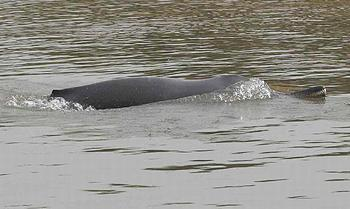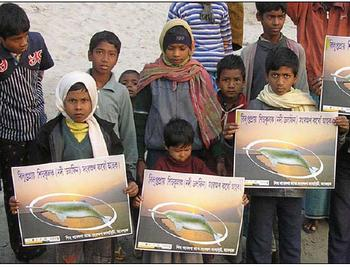 最近一項研究顯示,若想確保恆河豚持續在布拉馬普特拉河(Brahmaputra)河系裏生存的話,就必須建立恆河豚的保護區。該研究有鑒于印度石油有限公司(Oil India Ltd.)有意沿著布拉馬普特拉河河床,用空氣槍和炸藥來探勘石油的提議,繼而提出調查河豚實際存量的必要性。
最近一項研究顯示,若想確保恆河豚持續在布拉馬普特拉河(Brahmaputra)河系裏生存的話,就必須建立恆河豚的保護區。該研究有鑒于印度石油有限公司(Oil India Ltd.)有意沿著布拉馬普特拉河河床,用空氣槍和炸藥來探勘石油的提議,繼而提出調查河豚實際存量的必要性。
該報告作出結論表示,像這樣的探勘行動「對於恆河豚的生存條件所帶來潛在的影響是無法想像的。」
按估計,目前恆河豚(學名為Platanista gangetica gangetica)的總數約為2,000條。根據國際自然保育聯盟彼得蘇格蘭公爵基金(International Union for the Conservation of Nature's Sir Peter Scott Fund)的調查結果,印度的布拉馬普特拉河流域中,有240至300條的恆河豚以此為家。
與聖安德魯斯(St. Andrews)大學海洋哺乳動物研究單位的博洛利克(Gill Braulik)共同進行該項研究的計劃負責人瓦科德(Abdul Wakid)博士說:「我們的研究顯示,布拉馬普特拉河流域江豚所面臨的主要威脅是混獲,其次是非法鑽勘石油而導致意外死亡。」
瓦科德還表示:「人類活動也造成該物種棲地惡化的現象。布拉馬普特拉河的大壩建設和擬議中的地震調查無不是潛在的威脅。」
恆河豚主要分佈於印度和孟加拉國境内的恒河和布拉馬普特拉河河系。
根據 老一代居民的説法, 30年前恆河豚是布拉馬普特拉河河系最常見的一種大型水生動物。
老一代居民的説法, 30年前恆河豚是布拉馬普特拉河河系最常見的一種大型水生動物。
本次調查的範圍集中在布拉馬普特拉河河系一段長達1,044公里的河豚棲地。該河段主要位於印度東北部的阿薩姆邦。由同一個勘查團隊於2005年對同一河段進行調查做出的最佳判斷,顯示還有250條河豚。
該項目由樂團基金會(Fondation Ensemble)贊助,旨在補足布拉馬普特拉河恆河豚的分佈、數量、行為和聲學等基本資料,並對設立保護區的合適地點做出建言。
該計劃從2007年10月進行至2008年9月。工作人員針對布拉馬普特拉河流域,江豚出沒熱點周邊以打漁爲生的村落,進行了32個宣導活動。
該研究明確指出了8個可能成爲保護區的河段,並提及以社區為導向的江豚保育計劃才是挽救河豚的上上之策。
Dolphin protected areas must be established if the Ganges River dolphin is to survive in the Brahmaputra river system, new research indicates. The study was prompted by the need for accurate dolphin population data after Oil India Ltd. proposed to start prospecting for oil along the bed of the Brahmaputra River using air guns and explosives.
Such prospecting "has potentially disastrous implications for Ganges River dolphins," the report concludes.
Estimates have put the total population of the Ganges River dolphin, Platanista gangetica gangetica, at around 2,000. Between 240 to 300 of these inhabit the Brahmaputra River system in India, according to the survey prepared for the International Union for the Conservation of Nature's Sir Peter Scott Fund.
"Our research shows accidental killing through fisheries bycatch, followed by poaching for oil, are the major threats to the dolphins of the Brahmaputra river system," said project leader Abdul Wakid, Ph.D., who conducted the research with Gill Braulik of the University of St. Andrews' Sea Mammal Research Unit.
"Their habitat is also being degraded by human activities," said Wakid. "Dam building and a proposed seismic survey in the Brahmaputra river are potential threats."
The Ganges River Dolphin is found mainly in the Ganges and Brahmaputra river systems in India and Bangladesh.
According to older Assam residents, 30 years ago, the Gangetic dolphin was one of the most commonly sighted large aquatic animals in the Brahmaputra River system.
This survey concentrated on the 1,044 kilometer stretch of dolphin-inhabited Brahmaputra River system, primarily in the state of Assam in northeast India. In a 2005 survey of the same river stretch by the same investigating group a best estimate of 250 dolphins was recorded.
The project, funded by Fondation Ensemble, was designed to provide missing baseline information on distribution, abundance, behavior and acoustics of Ganges River dolphins in the Brahmaputra River and suggest suitable locations to establish protected areas.
The project took place from October 2007 to September 2008. Project workers carried out 32 awareness campaigns along the Brahmaputra valley, focusing on fishing communities in areas surrounding dolphin hotspots.
The study identified eight river sections as potential protected areas and community-based dolphin conservation as the best strategy to save the dolphins.





